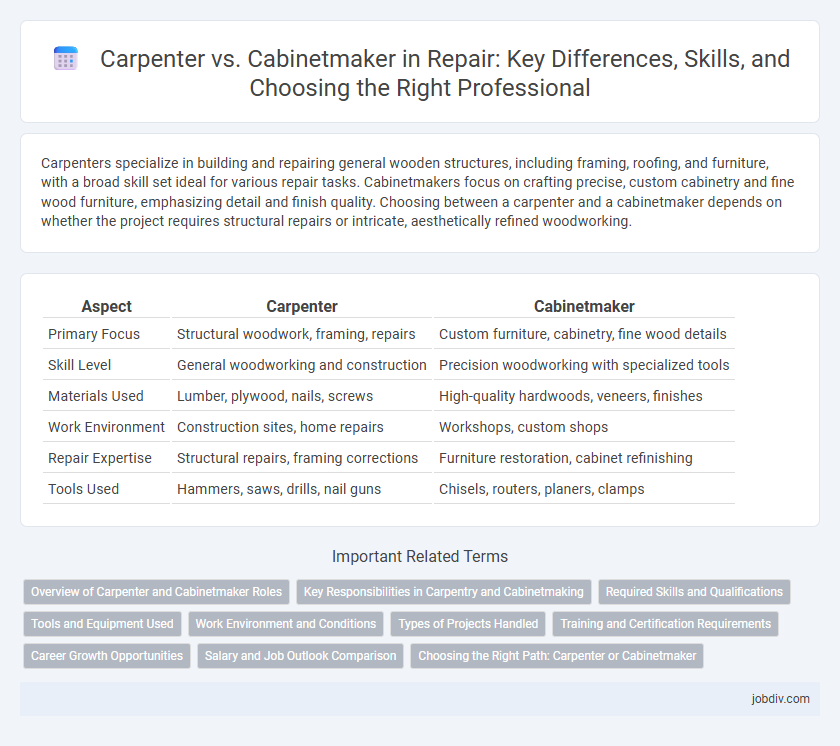Carpenters specialize in building and repairing general wooden structures, including framing, roofing, and furniture, with a broad skill set ideal for various repair tasks. Cabinetmakers focus on crafting precise, custom cabinetry and fine wood furniture, emphasizing detail and finish quality. Choosing between a carpenter and a cabinetmaker depends on whether the project requires structural repairs or intricate, aesthetically refined woodworking.
Table of Comparison
| Aspect | Carpenter | Cabinetmaker |
|---|---|---|
| Primary Focus | Structural woodwork, framing, repairs | Custom furniture, cabinetry, fine wood details |
| Skill Level | General woodworking and construction | Precision woodworking with specialized tools |
| Materials Used | Lumber, plywood, nails, screws | High-quality hardwoods, veneers, finishes |
| Work Environment | Construction sites, home repairs | Workshops, custom shops |
| Repair Expertise | Structural repairs, framing corrections | Furniture restoration, cabinet refinishing |
| Tools Used | Hammers, saws, drills, nail guns | Chisels, routers, planers, clamps |
Overview of Carpenter and Cabinetmaker Roles
Carpenters specialize in constructing and repairing structural elements such as frameworks, floors, and roofs, using a variety of hand and power tools. Cabinetmakers focus on crafting precise, detailed wood furnishings like cabinets, furniture, and millwork, emphasizing fine joinery and finishes. Both professions require woodworking expertise, but carpenters handle larger-scale construction projects, while cabinetmakers concentrate on detailed, custom wood pieces.
Key Responsibilities in Carpentry and Cabinetmaking
Carpenters focus on structural tasks such as framing, installing doors and windows, and building frameworks for buildings, emphasizing durability and load-bearing elements. Cabinetmakers specialize in crafting detailed furniture pieces, cabinetry, and fine woodwork, prioritizing precision and intricate design. Both professions require advanced woodworking skills but differ significantly in their scope and detail orientation within construction and repair projects.
Required Skills and Qualifications
Carpenters require skills in measuring, cutting, and assembling wood structures using hand and power tools, with a focus on framing, roofing, and general construction tasks; typically, a high school diploma and apprenticeship or vocational training are essential. Cabinetmakers specialize in precision woodworking, requiring advanced skills in designing, crafting, and installing fine furniture and cabinetry, often necessitating formal education in woodworking or fine carpentry and experience with detailed joinery techniques. Both professions demand strong attention to detail, manual dexterity, and knowledge of wood properties, but cabinetmakers typically have more specialized training in cabinetry and finish work.
Tools and Equipment Used
Carpenters primarily use hand tools such as hammers, saws, chisels, and measuring tapes, along with power tools like drills and nail guns for framing and general wood repair. Cabinetmakers rely on specialized equipment including precision routers, table saws, dovetail jigs, and sanders to create detailed and smooth finishes essential for fine cabinetry. Both trades depend on clamps and squares, but cabinetmakers emphasize tools that ensure accuracy and craftsmanship for customized joinery and intricate designs.
Work Environment and Conditions
Carpenters typically work on construction sites or residential areas, facing outdoor elements and variable weather conditions that demand physical endurance and adaptability. Cabinetmakers operate in controlled workshop settings, utilizing precision tools and machinery that require meticulous attention to detail and a stable indoor environment. Both trades involve manual labor, but carpenters handle broader structural tasks while cabinetmakers focus on fine woodworking and cabinetry.
Types of Projects Handled
Carpenters typically handle a wide variety of construction and repair projects including framing, roofing, and general woodwork, focusing on structural elements and functional aspects of buildings. Cabinetmakers specialize in crafting detailed, custom cabinetry and fine furniture, emphasizing precision and aesthetic quality for interior design elements. Both professions require woodworking skills, but carpenters are more involved in larger-scale construction repairs while cabinetmakers focus on intricate, decorative wood projects.
Training and Certification Requirements
Carpenters typically undergo apprenticeships lasting three to four years, combining on-the-job training with classroom instruction, while certification is often voluntary and varies by region. Cabinetmakers usually require specialized training focused on fine woodworking skills, often through technical schools or specialized programs, with certifications like AWI (Architectural Woodwork Institute) credentials enhancing professional credibility. Both trades demand strong attention to detail, but cabinetmaker certification standards are generally more rigorous due to the precision involved in cabinetry and furniture making.
Career Growth Opportunities
Carpenters and cabinetmakers both offer distinct career growth opportunities rooted in their specialized skills and industry demands. Carpenters can advance by gaining experience in construction management, project supervision, or specializing in framing, remodeling, or finish carpentry. Cabinetmakers often progress by mastering custom cabinetry, furniture design, and wood finishing techniques, enabling roles in bespoke manufacturing, design consultation, or workshop management.
Salary and Job Outlook Comparison
Carpenters earn a median annual wage of approximately $49,520, with job growth projected at 8% from 2022 to 2032, reflecting steady demand in construction and repair sectors. Cabinetmakers typically have a median salary around $47,700, with a slower job growth rate near 5%, as the role is more specialized and linked to custom furniture and cabinetry markets. Both professions offer stability, but carpentry presents broader opportunities and higher salary potential due to diverse applications in building and remodeling projects.
Choosing the Right Path: Carpenter or Cabinetmaker
Choosing the right path between carpenter and cabinetmaker depends on your repair and woodworking interests and skills, as carpenters handle broad construction tasks like framing and structural repairs, while cabinetmakers specialize in precise, detailed work such as crafting custom cabinetry and fine furniture. Carpentry requires versatility and familiarity with different building materials for general repairs, whereas cabinetmaking demands expertise in joinery, finishing, and design for high-quality, aesthetic woodworking pieces. Evaluating your passion for large-scale structural projects versus meticulous, decorative craftsmanship helps determine the best career choice for repair and woodworking specialization.
Carpenter vs Cabinetmaker Infographic

 jobdiv.com
jobdiv.com